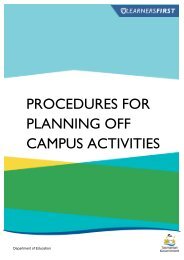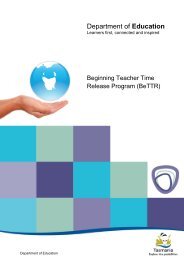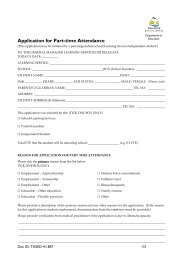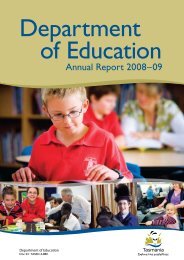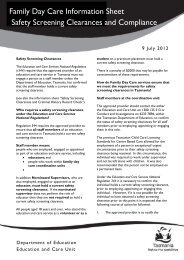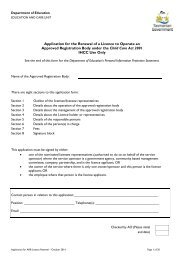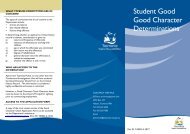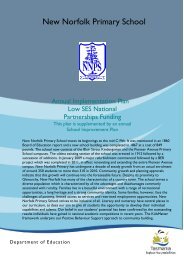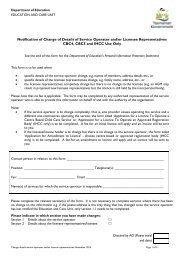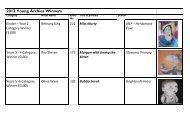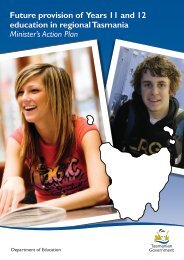Education
DoE Annual Report 2012-2013 - Department of Education
DoE Annual Report 2012-2013 - Department of Education
- No tags were found...
You also want an ePaper? Increase the reach of your titles
YUMPU automatically turns print PDFs into web optimized ePapers that Google loves.
Australian<br />
School-based<br />
Apprenticeships<br />
Over the past two years the department has undertaken<br />
considerable work to repackage and reposition Australian<br />
School-based Apprenticeships and Traineeships to<br />
support retention and attainment, skills development of<br />
young people and improve industry workforce planning<br />
and development to support economic growth.<br />
This work has included a major review and analysis of<br />
the delivery and management of Australian School-based<br />
Apprenticeships (ASbA) in Tasmania from 2001–11.<br />
The review has informed and driven the development<br />
of the Department of <strong>Education</strong> Smart Workforce<br />
Development, A Tasmanian Strategy 2013–2015.<br />
The implementation of this strategy is underpinned by the<br />
following four key action areas:<br />
Action Area 1: ASbA Support Skills Growth<br />
Growing the quality and quantity of ASbA across a range<br />
of targeted industry sectors is the key objective of the<br />
Tasmanian ASbA Strategy Action Plan. Specifically, the plan<br />
aims to increase the engagement of industry sectors<br />
that have been identified in the Tasmanian Economic<br />
Development Plan. The department is working closely with<br />
the transport and logistics, aquaculture, construction,<br />
hospitality and tourism industry sectors on the<br />
development of ASbA workforce development initiatives<br />
for each of these industry sectors.<br />
Action Area 2: Marketing and Promotion<br />
of ASbA<br />
There are a broad range of stakeholders involved in<br />
ASbA, however, for many of them, access to accurate<br />
and high quality information and advice on ASbA has<br />
not always been easy to find. To address this issue the<br />
department has undertaken the initial mapping for the<br />
development of an ASbA information portal. This portal<br />
will provide a centralised point of information which<br />
promotes ASbA to students, schools, parents and<br />
employers, providing them with access to high quality<br />
information on ASbA initiatives, requirements and<br />
approved pathways.<br />
Action Area 3: Improved Quality of<br />
ASbA Delivery and Management<br />
An ASbA program is most effective when all stakeholders<br />
work collaboratively to support young people and<br />
employers, however, many ASbA stakeholders have<br />
differing roles and responsibilities. Some stakeholders are<br />
easily identified while others work behind the scenes to<br />
provide support and maintain quality standards.<br />
The department has been working collaboratively with<br />
ASbA stakeholders to identify and implement a best<br />
practice approach towards coordination, management<br />
and support of ASbA.<br />
Action Area 4: ASbA Quality Assurance<br />
and Continuous Improvement<br />
Although the Tasmanian ASbA strategy targets the<br />
development of key actions to improve both the quality<br />
and outcomes of ASbA programs in Tasmania, it is<br />
critical that we remain open to the possibility of further<br />
improvement. It is for this reason that systems and<br />
procedures are being developed to ensure all aspects of<br />
ASbA programs are monitored, reviewed and improved.<br />
This will ensure that they are able to operate within<br />
the requirements of any future educational, social,<br />
employment or economic changes that may occur.<br />
Post-Compulsory <strong>Education</strong> and Skills Development<br />
45




